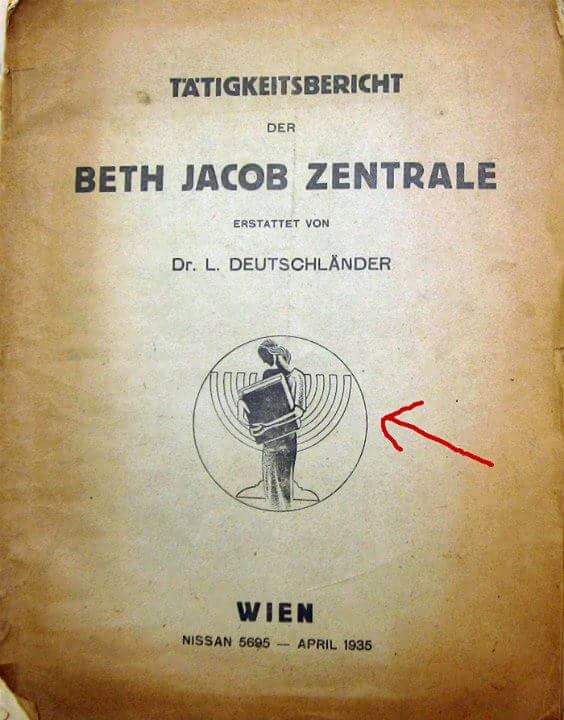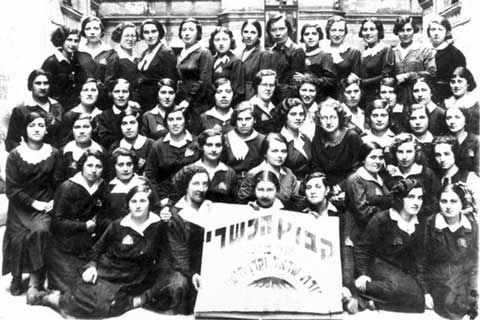So here’s a fun one: this is the logo that appeared on the financial report for the original Lodz Bais Yaakov. Meaning, it was almost certainly approved by Sarah Schnierer herself.
To be fair, though, the actual dress code of the graduates looks quite similar to contemporary requirements. They even appear to be all wearing black. (I think I see a collarbone all the way on the left, though…)


The whole “Bais Yaakov then and now” thing- or more “how we think of it vs how it was”- is seriously historically fascinating. My friend’s sister in law is literally writing the book- or more accurately doing her PhD dissertation- on it, and I heard her give a talk on it which was super interesting. Possibly the most interesting part is that her thesis is that even though there’s a bit of a feeling in the MO world that people overstate the “Bais Yaakovy”ness of how it really was, how it was more revolutionary, etc, she actually found in her research that it really was pretty traditional and Bais Yaakovy, for lack of a better word.
(It was marketed to philanthropists in the US by Agudah, though, as a revolutionary organization rescuing poor backwater uneducated girls from off the streets and giving them life survival tools. This in an era where girls were no longer being kidnapped and carted off to Argentina for prostitution-also a true story- but had mandatory public school and were living in good conditions. Sarah Schenirer was very uncomfortable with this kind of marketing but when it brought in money she made sure that some of it in fact would be used for helping the poorer girls.)
Other myths she busted about BY:
-They were not full service schools for the most part- they were generally afterschool programs which in small towns closed down after a few years which basically taught the girls to read and write in Yiddish and daven. Those which were full-day were so prohibitively expensive that only the wealthy could afford to go there, meaning that for the poor the only option was Bnos (which honestly was probably the most transformative part of BY in terms of keeping girls connected).
-Sarah Schenirer may have been influenced by German rabbanim, and she may have been more educated than the average girl in her time (who often could barely read Hebrew and Yiddish), but she wasn’t teaching complicated meforshim to the girls. Most of what she taught was chassidus, tefillah, machshava, etc, and she had little background in Tanach, etc. Once the Germans came in this changed somewhat, but not even that much.
-Bais Yaakov Seminary was an accredited Polish high school and therefore offered full secular studies.
LikeLike
I would LOVE to see that PhD thesis. BTW, this might help her a little bit:
https://drive.google.com/open?id=0B5SH5GIsE5n_aW9MVGl6cHVHdzQ
LikeLike
I would so love to see that too. Let us know when she defends!
LikeLike
> Sarah Schenirer may have been influenced by German rabbanim,
It sure seems that way judging by the picture above. You can’t get more German than, Dr. Deutshchlander.”
LikeLike
I’ll let you know when her dissertation is published- she’s compiling her research into book form now!
G3- of course she was influenced by German rabbanim (though she was a bit annoyed at Deutschlander for perpetrating the fundraising techniques I mentioned…) but what I meant to say is that despite her having been influenced by them, her personal Torah learning and knowledge level were still very Polish-chassidish, Tzena uRena, etc. Even once Judith Rosenbaum came it got better but only to a marginal extent.
LikeLike
My grandmother went to Bais Yaakov in Tomaszow (Poland) for a while until they were kicked out by people who thought BY was too radical. I have a picture of her sister at a BY Purim play which we used in our yearbook. (That’s a completely irrelevant point but I felt like saying it…)
The real kicker is that when we tried finding pictures for our yearbook, we couldn’t find any from the 50s, when “the” Brooklyn BY started in America, in which the women’s knees were covered. Whether they were sitting or standing, their skirts hit slightly above the knee. These were the rebetzins we were being told to emulate. And we probably should, because I’m sure they really were wonderful role models. But that doesn’t mean 4 inches below the knee…
LikeLike
Well, IIRC, my aunt briefly attended the Brooklyn Bais Yaakov, and she’s no rebbetzin. Then again, “briefly” may be the key word.
On Tue, Mar 22, 2016 at 9:05 AM, Tales Out of Bais Yaakov wrote:
>
LikeLike
Well, yeah, but I’m talking about photos of Rebetzin Kaplan et al.
LikeLike
My great-aunt briefly attended but was kicked out when my great grandfather could no longer pay tuition, so yeah…
LikeLike
Do you know why the report (or at least the cover) is written in German? As opposed to Yiddish, Polish, or Russian?
It’s impossible to say what color the dresses were, but there’s at least one (in the upper right corner) that wasn’t black.
LikeLike
I’d venture because it was in Vienna (Wien) which is in Austria, where German was the langauge.
LikeLike
Right, but why was the financial report for a school in Lodz printed in German in Vienna?
LikeLike
1923 Agudah Convention took all financial responsibility from Sarah Schenirer and gave it to a group of Germans, specifically Leo Deutschlander, so she didn’t need to worry about it. So everything was German-run afterward
LikeLike
I tend to think that person on the far left is wearing a “dickie,” considering the shadows in the photo and how it cuts off over the white. So no, I don’t think it is a collarbone.
As for BY being elitist — I always wondered about the story that Vichna Kaplan’s application was first rejected, until she wrote back and explained that her uncle didn’t allow her to attend secular school to get the mandatory high school diploma. Once SS knew who the uncle was (and being strategic, she needed these rabbanim to endorse her as she had much difficulty in some towns), she admitted Vichna. And then took her under her wing with favoritism.
LikeLike